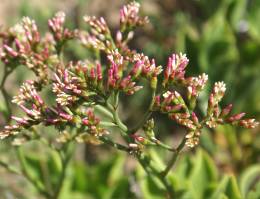Limonium peregrinum
Limonium peregrinum (P.J.Bergius) R.A.Dyer
Family: Plumbaginaceae
Common names: sea lavender (Eng.); papierblom, strandroos (Afr.)
Introduction
Sea lavender is a tough, low-growing shrub producing masses of papery, pink blooms in summer each year; it is highly suitable for coastal and home gardens.

Description
Description
Limonium peregrinum is the largest and most showy of South Africa's sea lavenders and is common in the coastal bush along the Cape West Coast. Sea lavender is an evergreen, naturally clump-forming shrub reaching a height of 100 cm, with bright green foliage. Branches are leafy towards the tips. The leaves are long and oblanceolate (broadest near the tips and tapering towards the base), 40-80 mm long and 10-20 mm wide. They clasp the stem at the base and have a rough texture.

One or more flowers in a flat-topped inflorescence can be seen arising well above the leaves on a naked flower stalk. The 5-petalled flowers are bisexual; the upper flowers being the youngest and the last to open. The striking petals are magenta with the calyx (outer envelope of the flower) dull pink and paper-like when dry. They remain present for a long time, thus the Afrikaans name of papierblom, meaning paperflower.

L. peregrinum is summer-flowering from November till February.
Conservation Status
Status
Its status is Least Concern, meaning that Limonium peregrinum is not threatened or rare and the population is not declining. They are found growing quite commonly in their natural habitat on the Cape West Coast.
Distribution and habitat
Distribution description
The indigenous Limonium peregrinum occurs naturally along the coastal dunes and on maritime sandy flats in low vegetation from the Cape Peninsula northwards to Clanwilliam in a relatively harsh environment.
They are tough plants; able to survive prolonged droughts, brackish soils as well as coastal winds. In their natural habitat they often grow very close to the sea in pure sand. Temperatures range from cool in winter to dry and hot in summer.
Derivation of name and historical aspects
History
Limonium belongs to the Plumbaginaceae family. The genus gets its name from the Greek word leimon, meaning a meadow. The specific name peregrinum is Latin and means foreign, strange, alien or exotic.
There are ± 350 species of Limonium worldwide, occurring in maritime and arid regions of the northern hemisphere, Africa and Australia, but mostly in the Mediterranean. One common relative from Europe seen in many South African coastal gardens is Limonium perezii with its large leathery leaves and bright purple and white flowers.
Ecology
Ecology
The flowers are pollinated by insects. Seeds are found within a dry, membranous capsule, a single seed per flower.

Uses
Use
Worldwide many species are used as popular hardy fillers in the cut flower trade. Limonium perigrinum can be used in both fresh and dried bouquets.
Growing Limonium peregrinum
Grow

L. perigrinum is not difficult to grow, provided it has an open, sunny position and a well-drained sandy growing medium. It resists drought near the sea but inland it must not be allowed to dry off completely at any time of the year. It is moderately hardy to frost but must be protected in the first year. Plants are best reared from seed sown in autumn in very sandy soil, to be pricked out in the following spring.
Sea lavender is very drought-tolerant once established and will need minimal watering. It is ideal for difficult windy gardens on the sandy flats around Cape Town as well as coastal gardens. This medium-sized shrub will provide summer colour and must be planted in a position with full sun.
References
- Cunliff, J & Teicher, U, 2005. Botanical names and their meanings. http://www.biosciencecommunications.dk/botanical
- Jackson, W.P.U., 1980. Wildflowers of the fairest Cape. Howard Timmins Publishers, Cape Town.
- Manning, J. & Goldblatt, P. 2007. West coast. South African Wildflower Guide 7. Botanical Society of South Africa, Cape Town.
- Raimondo, D., Von Staden, L., Foden, W., Victor, J.E., Helme, N.A., Turner, R.C., Kamundi, D.A. & Manyama, P.A. (eds). 2009. Red List of South African plants. Strelitzia 25. South African National Biodiversity Institute, Pretoria.
- Van Jaarsveld, E. 1997. Strandroos aantreklik, geskik vir moeilikeStrandveldtuine. http://152.111.1.87/argief/berigte/dieburger/1997/03/01/4/1.html
Credits
Nicolette Stoll
Millennium Seed Bank Project
Kirstenbosch National Botanical Garden
January 2011
Plant Attributes:
Plant Type: Ground Cover, Perennial
SA Distribution: Northern Cape, Western Cape
Soil type: Sandy, Loam
Flowering season: Spring, Early Summer, Late Summer
PH: Acid, Alkaline, Neutral
Flower colour: Pink
Aspect: Full Sun
Gardening skill: Easy
Special Features:
Horticultural zones








Rate this article
Article well written and informative
Rate this plant
Is this an interesting plant?
Login to add your Comment
Back to topNot registered yet? Click here to register.